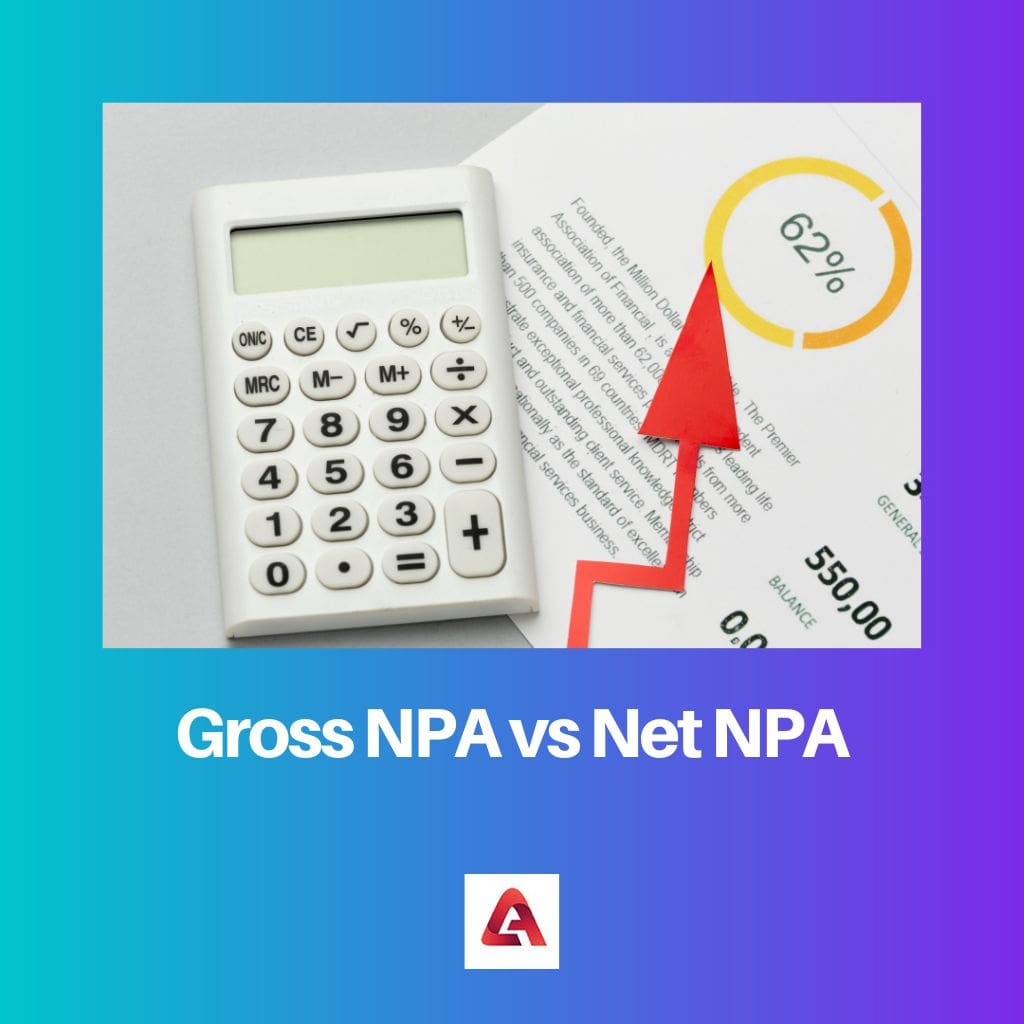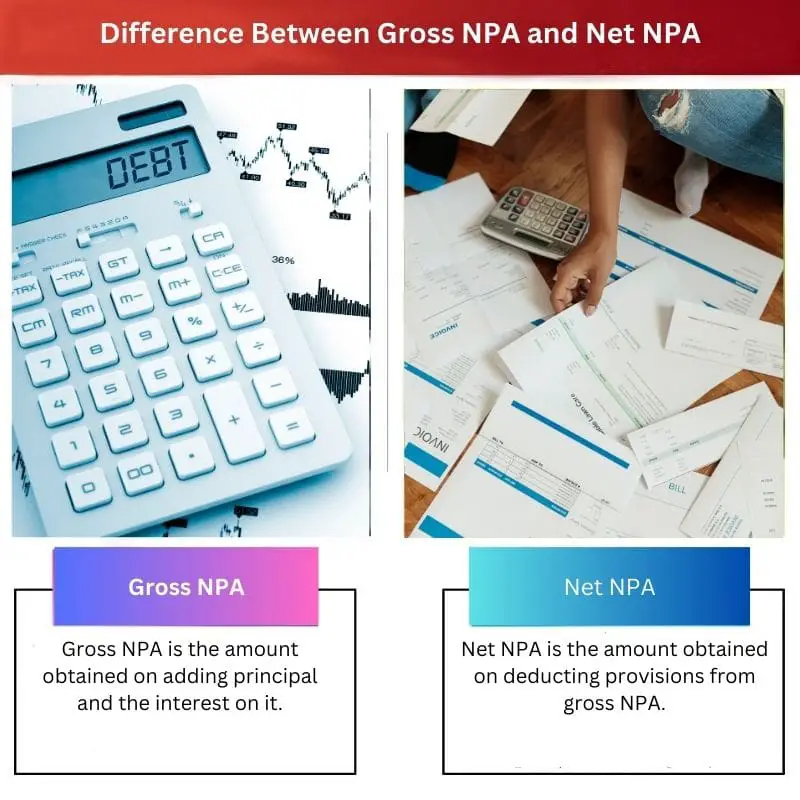NPA, or, Non-performing assets, are loans that have been left unpaid for a long time after the completion of the repayment time. Such assets are added to the bank’s balance sheets after a long period.
Usually, the 90-day period is standard; however, the time can be longer or shorter, as mentioned in the terms and conditions at the lending time.
Key Takeaways
- Gross NPA (Non-Performing Assets) is the total value of loans a financial institution has issued that are not being repaid or generating income without considering any provisions or recoveries made by the institution.
- Net NPA is the value of non-performing assets after considering provisions and recoveries made by the financial institution, providing a more accurate representation of the institution’s potential losses.
- The main difference between gross NPA and net NPA is the consideration of provisions and recoveries, with gross NPA representing the total value of non-performing loans. In contrast, net NPA considers provisions and recoveries to clarify the financial institution’s risk exposure.
Gross NPA vs. Net NPA
The difference between gross NPA and net NPA is that Gross NPA is a nonperforming asset that includes both the principal and the interest amount. At the same time, Net NPA is the asset obtained after subtracting provisions from the initial amount.

The gross non-performing asset is calculated by adding the interest and the principal amount. The net non-performing asset is calculated by deducting the doubtful and bad debt provisions from the original asset.
Comparison Table
| Parameter of Comparison | Gross NPA | Net NPA |
|---|---|---|
| Basic definition | Gross NPA is the amount obtained by adding principal and interest. | Net NPA is the amount obtained by deducting provisions from gross NPA. |
| Formula for calculation | Gross NPA= (A1+ A2+…………….+An)/ Gross Advances, here, A1 to An is the amount lent to persons 1 to N. | Net NPA= (Gross NPA- Provisions related to unpaid debt)/ Gross Advances. |
| Actual loss incurred | Gross NPA is not the actual loss incurred by the financial institution. | Net NPA is the actual loss faced by the financial institution. |
| Default period | The institution gives a grace period after which the principal with interest is to be repaid; after the expiration of this period, it becomes nonperforming. | Net NPA does not offer any grace period. |
| Effects on the financial institution | Gross NPA harms the market image of the institution and its equity value. | Net NPA affects the liquidity and profitability of the company. |
What is Gross NPA?
Gross NPA is the sum of the principal and the interest paid on it. It shows that the landed amount is at the potential risk of being unpaid. The formula for calculating Gross NPA is-
Gross NPA= (A1+A2+A3+A4+……………..+An)/Gross Advances
Here, A1 to An represents the loan amount for the person 1 to n.
The institutions give the person a grace period of 90 days, after which the loan is to be repaid, failing which the asset becomes Gross NPA.
The gross NPA ratio shows the company’s asset quality; the higher the ratio, the lower the asset quality. The ratio of Gross NPA is defined as the ratio of total gross NPA to the total advances of the institution.
The poor implementation of governmental policies, natural calamities, industrial sickness, etc., causes gross NPA. Gross NPA defames the institution’s goodwill or image and lowers the company’s equity value.

What is Net NPA?
It is the amount obtained when the principal amount is deducted from the payments received from the person who lent it. The following formula calculates net NPA-
Net NPA= ( Gross NPA- provisions of unpaid debt)/ Gross Advances
Net NPA does not give any grace period; the loan becomes Net NPA immediately. Net NPA is the actual loss faced by the lending institution.
Net NPA to advances ratio is the Net NPA to Net Advances ratio. It measures the quality of the loan of the institution and the overall health of it.
The low number of provisions for unpaid debts causes net NPA. The higher amount of Net NPA affects the liquidity and profitability of the company. It shows the company is going to a loss.

Main Differences Between Gross NPA and Net NPA
- Natural calamities cause gross NPA, poor governmental policies and implementations, and industrial sickness, while the low provisions for unpaid debts cause Net NPA.
- The higher ratio of gross NPA indicates that the lending institution’s asset quality is in poor condition. At the same time, Net NPA shows the institution’s poor financial condition.

This article could use more in-depth analysis of the impact of NPA on the banking system’s health and economy as a whole.
A well-articulated piece on NPA and its implications. The inclusion of a comparison table was particularly helpful.
I appreciate the clear emphasis on the impact of NPA on the financial institution’s equity value and liquidity.
The lack of real-world examples makes the article less relatable to the practical scenarios of NPA management.
While the article covers the basics, it lacks a critical exploration of the preventative measures institutions could take to manage NPA effectively.
The article simplifies the complex concepts of gross NPA and net NPA, making it accessible for a broad audience. Well done.
I appreciate the effort to demystify the jargon associated with NPA. It’s a great read for those new to the subject.
I agree, the simplicity of the language used to explain these financial terms is commendable.
The article provided a useful comparison between gross NPA and net NPA, making it easier to comprehend their significance in the financial sector.
I found the article to be educational, but it could benefit from more real-world examples to illustrate the concepts.
This article provides comprehensive and easy-to-understand explanation of the difference between gross NPA and net NPA. The examples used to demonstrate the concept are very helpful.
I appreciate the clear breakdown of the calculation formulas for both gross NPA and net NPA. It’s quite enlightening.
Yes, it is an excellent resource for understanding the intricacies of NPA. Great article.
The article’s informative tone makes it a valuable resource for individuals seeking a deeper understanding of gross NPA and net NPA.